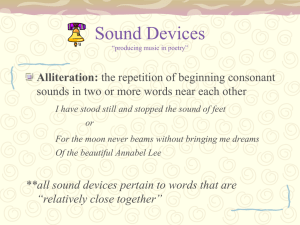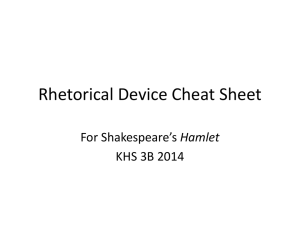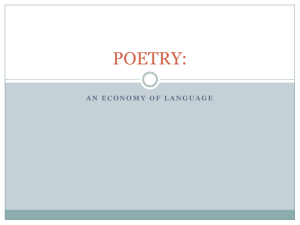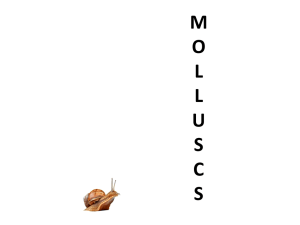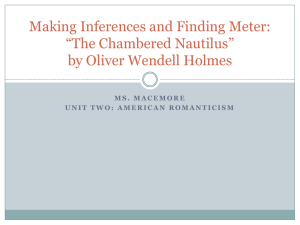Rhythm and Scansion - Sanderson High School
advertisement
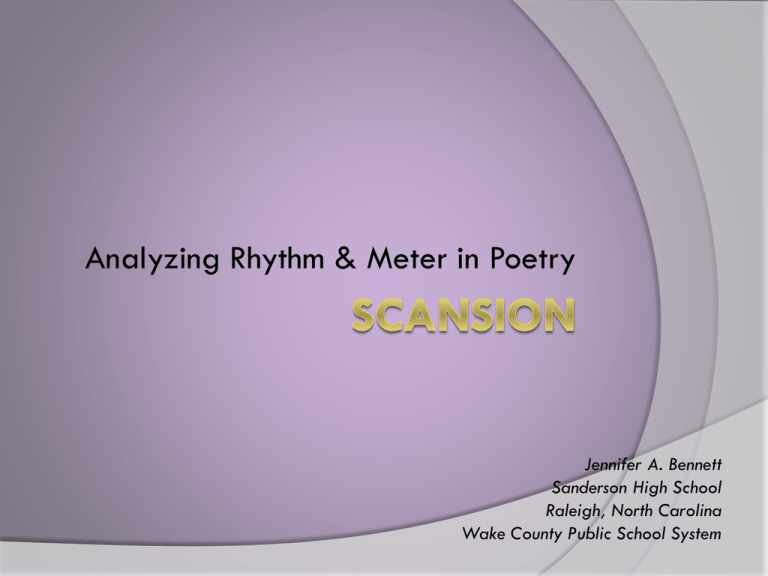
Analyzing Rhythm & Meter in Poetry Jennifer A. Bennett Sanderson High School Raleigh, North Carolina Wake County Public School System Common Vocabulary Syllabification: dividing a word into its syllables (each syllable has its own beat) Scansion: analyzing and marking the stressed ( ) and unstressed ( ) syllables of the words in the lines of a poem to determine the pattern of foot and meter Rhythm: the pattern of beats created by the stressed ( ) and unstressed ( ) syllables of the words in the lines of a poem Foot: the smallest unit of rhythm in a line of poetry Meter: measuring the number of feet in a line of poetry Scansion 1. Steps: Mark every syllable to determine whether each is stressed or unstressed. The stressed and unstressed beats in polysyllabic words are already set—they don’t change. Whether a monosyllabic word is stressed or not depends on the rhythmic pattern created by the other words surrounding it. 2. Identify any rhythmic pattern—look for the repetition of a poetic foot. Ex. "And the sheen of their spears was like stars on the sea” Repeated foot: [ 3. ] Count the number of feet in each line to determine meter. [ ]x4 The Poetic Foot Foot: The smallest unit of measurement in a line of poetry Made up of given combinations of stressed and unstressed beats Repetition of a foot creates a regular rhythm Iambs & Trochees Iamb (n) / iambic (adj) foot u|nite de|pend be|neath Trochee (n) / trochaic (adj) foot tro|chee rea|per tea|cher Anapests & Dactyls Anapest (n) / anapestic (adj) foot to the dance not a chance in between Dactyl (n) / dactylic (adj) foot yes|ter|day hap|pi|ly Spondee Spondee sounds like . . . Spondees & Dibrachs Spondee Two house|holds Who’s there? Hence, home you idle creatures, get you home! Dibrach (aka: pyrrhic foot) "When the blood creeps and the nerves prick” "To a green thought in a green shade" Meter: the number of feet in a line one foot = monometer Foot Meter Ex. one trochee in a line = trochaic monometer two feet = dimeter Ex. two dactyls in a line = dactylic dimeter three feet = trimeter Ex. three anapests in a line = anapestic trimeter four feet = tetrameter Ex. four dactyls in a line = dactylic tetrameter five feet = pentameter Ex. five iambs in a line = iambic pentameter six feet = hexameter Ex. six trochees in a line = trochaic hexameter Practice Time! 4x[ ] = _________ic ________meter 2x[ 6x[ 3x[ ] = ____________ ____________ 1x[ ] = ____________ ____________ 5x[ ] = ____________ ____________ 4x[ ] = ___________ _____________ 3x[ ] = _________ic ______meter ] = ____________ ____________ ] = ___________ _____________ Scan the following lines, and identify the pattern: TIGER, tiger, burning bright In the forests of the night, What immortal hand or eye Could frame thy fearful symmetry? So What? (What are the effects?) TIGER, tiger, burning bright In the forests of the night, What immortal hand or eye Could frame thy fearful symmetry? Iambic Pentameter But soft! What light through yonder window breaks? It is the East, and Juliet is the sun. .................................... From forth the fatal loins of these two foes A pair of star-crossed lovers takes their life. More Fair is foul, and foul is fair. Hover through the fog and filthy air. ~~~~~~~~~~~~~~~~~~~~~ Double, double, toil and trouble, Fire burn and cauldron bubble. Stanza Division Couplet: two lines Heroic Couplet: two rhyming lines of iambic pentameter Tercet: three lines Quatrain: four lines Quintain: five lines Sestet: six lines Septet: seven lines Octave: eight lines More Common Vocabulary Structure: any element in a poem that creates form, that organizes the words and ideas in a poem, including line breaks, rhythm, rhyme, syntax, tone shifts, etc. Open Form: (a.k.a. “free verse”) poetry that does not follow a regular or prescribed pattern of rhyme, rhythm, meter, line or stanza length; relies more on the rhythms of natural speech Closed Form: poetry that does follow a regular or prescribed pattern (ex. sonnets, sestinas, haikus, limericks, villanelles, ballads, etc.) The Haiku The Ballad The Sonnet The Villanelle The Sestina


